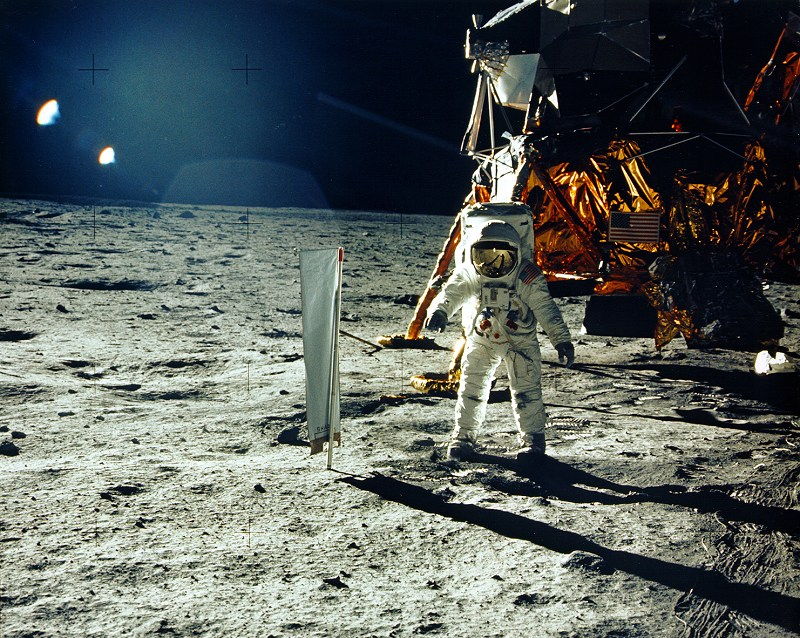Sotheby's to Auction Apollo 11 Moon Rock Bag Used for First Lunar Sample

An Apollo 11 moon rock bag that was at the center of a legal dispute is now set for what could be a record-setting auction.
The moon-dust stained, lunar sample return pouch will be offered as part of Sotheby's first space history-themed sale to be held in more than 20 years. The auction is scheduled for July 20, the 48th anniversary of the Apollo 11 mission's historic first moon landing, in New York City.
The zippered bag, which was used to protect the first-ever samples of lunar material collected by an astronaut off the surface of the moon, is expected to sell for $2 to $4 million — potentially more than any space exploration artifact has ever commanded at auction. [NASA's Apollo 11 Moon Landing in Photos]
"This seemingly modest bag ... played a crucial role in the most important scientific task of the Apollo 11 mission — to bring back the first sample of lunar material ever collected. To be able to see such an object in person is a once in a lifetime opportunity," Cassandra Hatton, vice president and senior specialist in charge of the space exploration sale at Sotheby's, said in a statement.
"It is one thing to read about going to the moon; it is quite another to hold in one's hands an object that was actually there and still carries traces of that faraway place," Hatton said.
Apollo 11 artifacts are rare in private hands. The command module Columbia that carried Neil Armstrong, Buzz Aldrin and Michael Collins from the Earth to the moon and back, as well as the crew members' spacesuits and most of their equipment, were transferred by NASA to the Smithsonian in the 1970s. The astronauts retained some items flown on the mission as mementos, and some have been sold in the nearly five decades since.
But most of those sales were for items that were launched specifically as souvenirs — for example, patches, medals and postmarked envelopes. Of those that were not, most were items that were used in lunar orbit, not on the surface of the moon.
Breaking space news, the latest updates on rocket launches, skywatching events and more!
The lunar sample return bag, which Sotheby's describes as "the only such artifact in private hands," would likely be in a museum today had it not been for an inventory error and the improper sale of other space artifacts by a former curator at a space museum in Kansas.
The bag, known to be flown but at the time unassociated with the Apollo 11 mission, was mistakenly sold in 2015 on behalf of the U.S. Marshals Service to cover the restitution due by the co-founder of the Cosmosphere in Hutchinson, Kansas, who was convicted of stealing and selling space artifacts belonging to the museum and NASA. The pouch was offered at auction three times, before finally selling for just $995.
Nancy Lee Carlson of Inverness, Illinois, won the bag and, in a bid to learn more about its history, sent it for analysis to NASA's Johnson Space Center in Houston, Texas.
"Scientific tests revealed the dust in the bag to be moon dust, specifically from the Apollo 11 landing site and a part number printed inside of the bag matched up to that of the "Contingency Lunar Sample Return Decontamination Bag" listed in the Apollo 11 stowage list," Sotheby's stated.
NASA, having no record of ever releasing the bag from its inventory, refused to return it to Carlson, instead offering to refund her the money she had spent. Carlson refused and the dispute became the subject of two court cases.
In December 2016, a U.S. District Court in Kansas ordered that the lunar sample bag belonged to Carlson, citing that the government had not provided sufficient justification to overturn the U.S. Marshals' sale. A Texas judge followed suit, instructing NASA to turn over the Apollo 11 moon rock bag to Carlson.
Carlson was returned the bag at Johnson Space Center on Feb. 27 and subsequently consigned it to the auction.
Sotheby's first entered the space memorabilia market with a pair of high profile Russian artifact auctions in 1993 and 1996. For the Apollo 11 bag to set a new sale record, it will need to surpass another Sotheby's lot, the 2011 auction of a Soviet Vostok space capsule for $2,882,500.
The most paid to date for a U.S. space artifact was $1.625 million for a Bulova wristwatch worn by Apollo 15 astronaut David Scott on the moon in 1971. The 2015 sale was held by RR Auction of Boston.
According to Sotheby's, Carlson plans to share a portion of the sale proceeds with a number of charities, including the Immune Deficiency Foundation and Bay Cliff Health Camp Children's Therapy and Wellness Center in Michigan. She is also planning to fund a scholarship for students studying speech pathology at Northern Michigan University.
Watch a video of NASA returning the moon rock bag to Nancy Carlson at collectSPACE.
Follow collectSPACE.comon Facebookand on Twitter at @collectSPACE. Copyright 2017 collectSPACE.com. All rights reserved.

Robert Pearlman is a space historian, journalist and the founder and editor of collectSPACE.com, a daily news publication and community devoted to space history with a particular focus on how and where space exploration intersects with pop culture. Pearlman is also a contributing writer for Space.com and co-author of "Space Stations: The Art, Science, and Reality of Working in Space” published by Smithsonian Books in 2018.
In 2009, he was inducted into the U.S. Space Camp Hall of Fame in Huntsville, Alabama. In 2021, he was honored by the American Astronautical Society with the Ordway Award for Sustained Excellence in Spaceflight History. In 2023, the National Space Club Florida Committee recognized Pearlman with the Kolcum News and Communications Award for excellence in telling the space story along the Space Coast and throughout the world.



